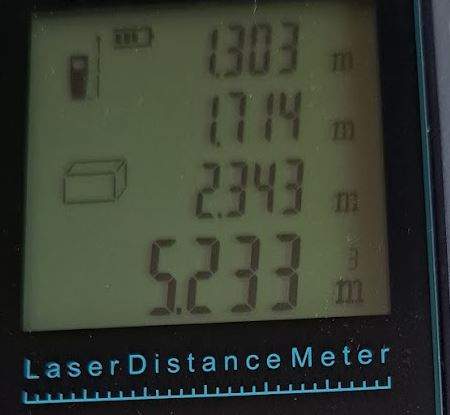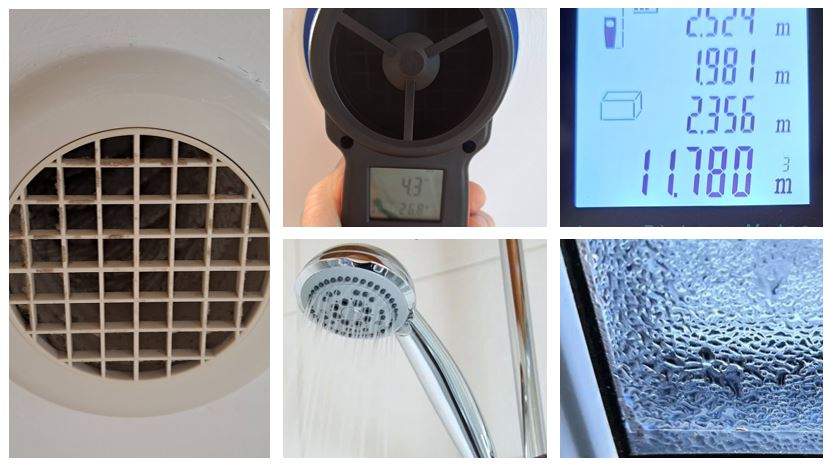Bathroom Extractor Fan – Best Option For You
We have written in other informative articles about how bathrooms, including ensuite bathrooms are one of the major sources of humidity / moisture in a property and can be a contributing factor to:
A bathroom extractor fan has several key purposes:
- To control / manage steam and humidity levels from bathing and showering
- And so to help prevent condensation, damp and mould
- This is not only in the bathroom but around the house too
- This is especially the case in adjoining rooms
- It is also especially important in winter / colder months
This is where our dew point calculator and dew point chart comes in very handy too!
Extractor fans are negative pressure (i.e. suction – hence ‘extractor’ fan) ventilation. They can take many forms and work differently to a PIV Unit vent (PIV units are ‘positive’ ventilation).

As you will know, when you take a bath or shower, they add steam to the air which, if it is not removed with a bathroom extractor fan and general ventilation (including air bricks), will build up and settle on surfaces (especially cold ones) as condensation. We talk about this in our guide to cold spots.
In fact, within our article about how to stop condensation on windows, number two on that list was ‘Have good extractor fans in your bathroom’. We said in that article:
“Extractor fans are common in bathrooms. They are there to remove the moist air out of your property to help tackle excess moisture in your house coming from the steam from baths and showers. Notice also that we say good extractor fans. That is because a poor extractor fan or an old one may not be up to capability. We have ways of measuring airflow through extractor fans, most commonly we rate them for cubic feet or cubic metres per minute”.
Bathroom Extractor Fans – Size and Capacity
You will see in the paragraph above that we have bolded the two points about good and capable extractor fans but why is this important?
You can see from the chart below how when you take a bath or shower in your house how relative humidity builds up and this will be affected by (a) the amount of water vapour (steam) given off by the bath or shower etc, but also (b) the size of the room.

In order to remove / control the moisture in the room you need an appropriately sized bathroom extractor fan. Most modern bathroom extractor fans (in-line, axial or centrifugal) have various ratings on them, including what their air extraction rate is. Nowadays, these facts and statistics tends to be shown in litres per second or metres cubed per hour.
If you look at some of the UK bathroom extractor fan such as Wickes or others, or on manufacturers such as Manrose, it will include data on this.
For example, one of the ones we just quickly checked said – “An impressive extraction rate of 90m3/hr, 25 litres per second”. Just to explain those numbers:
- 25 litres per second…
- Is 1,500 litres per minute
- Is 90,000 litres per hour
- Knowing that one meter cubed is 1,000 litres…
- That is 90m3/hr
Which brings us nicely along to the next question?
Bathroom Extractor Fan – What Size do I Need?
If you look at page 8 of the Government Building Regulations it says a minimum of 15 litres per second which is 54m³ per hour. But of course, room size is something to consider too as is whether or not you have an openable window too. For example, some ensuite bathrooms may not have a window at all.

The general rule of thumb for this, some recommend that you need at least 10 air exchanges per hour. What does that mean? Let’s take a look at two examples:
Example 1 – Ensuite Bathroom
- The dimensions above of 1.30m width x 1.71m length x 2.34m height
- As you can see, the laser distance measurement meter does the calculation
- The room volume is 5.23m³
- So 10x that is 52.3m³
- The fan we mentioned earlier was 90m³/hr
- That is 17.2 times per hour so more than enough
Example 2 – Main Bathroom
- The of that are 1.98m width x 2.36m length x 2.35m height
- The room volume is 11.78m³
- So 10x that is 117.8m³
- The fan we mentioned earlier was 90m³/hr
- That is 7.64 times per hour not really enough alone
You can see more about this in our Bathroom Extractor Fan Calculator
But how do you know if your extractor fan is sufficient, especially if you do not have the original instructions, know the model number or (perhaps more commonly) it is old and not running at full or original capacity / speed. Well, the next section shows a test.
Bathroom Extractor Fan Test
There are tests you can do on a bathroom extractor fan, using an anemometer. Importantly, to give a better reading you need an anemometer with a hood on it to give a good ‘seal’ around the fan to give better more accurate readings.
You can see that below, we are testing the existing fan in the ensuite bathroom mentioned above.

As you can see, it is giving a reading of 1.1 m/s (meters per second), which of the anemometer we are using and the fan diameter is 110m³ per hour. Remember that room is 5.23m³ and so is 21 air exchanges per hour which is more than enough.
Lets do the same for the main, larger bathroom too.

As you can see this has a reading of 4.3m/s which is much faster then the other. That said, it is an in-line extractor fan placed and ducted in the loft (venting to the outside to avoid loft condensation!) which is higher rated and in a larger bathroom, so the results are expected. But is it big enough for the larger bathroom? Lets take a look.
On this setup, 4.3m/s is approximately 430m³, which for an 11.78m³ bathroom is 36x more so again, more than enough for that size of bathroom. Good to know.
Condensation and Mould in Bathrooms
In our article about the signs of a water leak, we mentioned how there are a few signs of a leak to watch out for. Several of these things can be linked with property ‘damp’ problems in bathrooms and can in fact be related ked to condensation problems (and then mould problems).
Over time, if moisture in a bathroom (or rooms around) is not controlled, the steam from bathing and showering will settle on surfaces, reaching dew point and forming condensation on various surfaces. This in turn can cause damp patches on ceilings etc
This can then, over time, can cause direct water damage at a property or secondary issues such as mould problems on the areas affected as mould needs moisture to grow and spread.
You can measure surface temperatures with an infrared laser thermometer to help this process of understanding if this is part of the problem.
A bathroom or kitchen extractor fan helps to remove moisture, control humidity and helps to prevent some of these issues in properties. If you have a problem with damp, condensation problems or mould, contact us and we can help identify the cause of the problem and recommend how to resolve it. We can also remove mould our dry properties if needed too.
Bathroom Extractor Fans – other articles
Here are a few other articles which you may find useful:
- Ceiling Shower Leak Causes
- F1 Boiler Errors
- Leak Detection Specialists Explained
- Thermal Imaging Leak Detection
- Desiccant Dehumidifiers Simple Guide
- Do Fans Cool Well? Power Costs To Run – UK In 2022
You can also check out our water leak calculator and water leak detection services.

Are extractor fans in bathrooms worth it?

In our opinion, yes. Bathroom extractor fans help to remove moisture and humidity caused by having a bath or shower in particular. Providing they are adequately sized and performing effectively they will help stop problems with condensation, damp and mould in your property and not just in the bathroom, the adjoining rooms and the rest of the house too. This is especially important in winter months.
Do bathroom fans need to be vented outside?

Yes, bathroom fans do need to vented to the outside in order to extract moisture associated with bathing and showering to be removed outside and to help prevent damp and condensation that this humid air could otherwise cause. It is important not to vent bathroom fans into loft spaces as that could cause issues with damp or condensation in loft spaces.
Do extractor fans use a lot of electricity?

Generally, no, extractor fans do not use a lot of electricity and are relatively cheap to run, especially considering the benefits they bring. For example, a typical extractor fan might be 15 to 25 watts. Even with modern higher electricity prices, that 25w is just one-fortieth of a kilowatt. So if your electricity is 35p per KWh then to run it for an hour would cost less than a penny which, in our view, is well worth it for the benefits.
